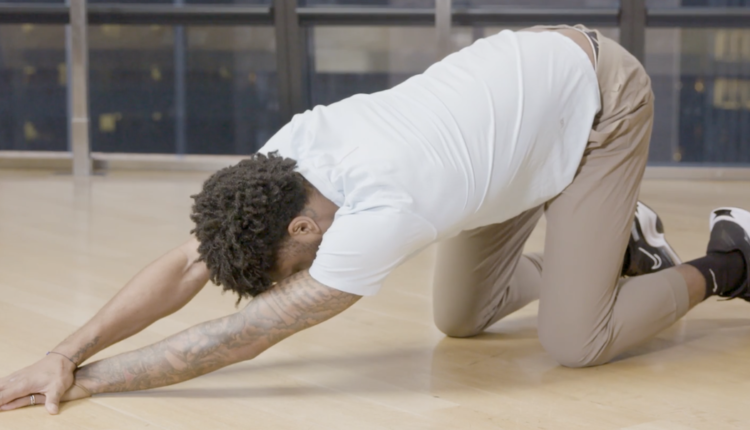IF YOUR SHOULDER feels like it’s stuck in place sometimes, it might be frozen. No, really.
Frozen shoulder causes pain and mobility issues in nearly five percent of Americans, most commonly in adults 40 to 60 years old. In some cases the shoulder can become almost totally immobile if left untreated. We use our shoulders for so many things, so if you’re having issues with pain and stiffness in the area, you’ll find that you’re hindered in more areas than you’d expect.
It’s a sticky situation to say the least. Luckily, Cameron Yuen, DPT, PT at Bespoke Treatments in New York City is here to show us some movements that will help mobilize the joint and get your movement back to normal.
What is Frozen Shoulder?
Frozen shoulder, also known as adhesive capsulitis, is characterized by stiffness and pain in the capsule of the shoulder. The shoulder joint is surrounded by a web of connective tissues, and these tissues can thicken and tighten around the joint, making movement very difficult.
This issue can happen for a number of reasons. Frozen shoulder can be the result of lingering injury, like a dislocated shoulder, or an illness, such as cardiovascular disease or diabetes. Sometimes, it happens with no easily discernible reason at all— this is called idiopathic adhesive capsulitis.
Recovering from frozen shoulder can be a long and arduous process. These exercises and stretches can help. Make sure you listen to your body as you progress through these— nothing good comes from pushing into pain. If it feels like your symptoms are getting worse, see a physical therapist or doctor to get more individualized treatment.
4 Exercises for Frozen Shoulder
Hook-Line Pec Stretch
Grab your foam roller and hit the deck. If you feel like your frozen shoulder has really caused your chest to tighten, rounding out your upper back, this stretch is for you.
How to Do It:
- Lie down with the foam roller supporting your spine. Keep your knees bent, feet flat on the ground.
- Tuck the pelvis down, lengthening out the spine.
- Allow the shoulders to relax towards the ground, palms up towards the sky.
- Start pulling the arms away from the sides of the body, only going to where the arm stays on the ground.
- Hold for 10 breaths, and re-evaluate how the body feels. If you feel a little more pain, back off a bit for the next rep.
- Aim for 5 reps, as often as you need throughout the day.
Quadruped Lat Mobilization
The lats, the large muscle down the sides of your back, can tighten up when the shoulder feels stuck. This can prevent you from easily reaching up overhead. This stretch will help mobilize those lats.
How to Do It:
- Start in the quadruped position, with your wrists underneath your shoulders and your knees underneath your hips.
- Cross the hand of the shoulder that feels the pain over in front of the other.
- Place the other hand on top.
- Sink the hips back towards the heel of the painful side, until you feel a comfortable stretch through the lats.
- Breath out as you sink back, and breathe in as you return to the upright.
- Do 3 to 4 sets of 10 to 15 reps, as many times a day as you need.
Hook Line Pullover
Now that you’ve stretched out, it’s time to incorporate some exercises. These will train the brain to allow the shoulder to move with better range of motion again. Have a light dumbbell or plate handy for this one.
How to Do It:
- Lie flat, with the knees bent up and feet flat to the ground.
- Hold the weight up over the chest, punched up towards the ceiling.
- Pull the weight back behind your head, as far as you can.
- If it feels too easy, pull the feet off the ground by bringing the hips to a 90 degree angle. Squeeze the core.
- Do 3 to 4 sets of 8 to 10 repetitions. Only do this once a day— the muscles need time to recover.
Prone Retraction
Antagonist muscles oppose the movement of a targeted muscle. Every muscle in our body has an antagonist. For the shoulder, these are the muscles of the upper back. It’s important to work these, as they can get very stiff with frozen shoulder.
How to Do It:
- Lie flat on your stomach, keeping the arms close to the sides of the body.
- Slowly lift the arms up towards the ceiling, squeezing the shoulder blades together.
- Make sure the neck and lower back are relaxed and pressed to the floor.
- If this is comfortable, progress by pulling the arms farther away from the body. Only go to shoulder height.
- Do 3 to 4 sets of 10 to 15 reps. Only do this once a day— the muscles need time to recover.
For more advice from physical therapists to help you move and feel better, check out all of our guides in The Fix series.
Cori Ritchey, NASM-CPT is an Associate Health & Fitness Editor at Men’s Health and a certified personal trainer and group fitness instructor. You can find more of her work in HealthCentral, Livestrong, Self, and others.
Brett Williams, a fitness editor at Men’s Health, is a NASM-CPT certified trainer and former pro football player and tech reporter who splits his workout time between strength and conditioning training, martial arts, and running. You can find his work elsewhere at Mashable, Thrillist, and other outlets.


Comments are closed.